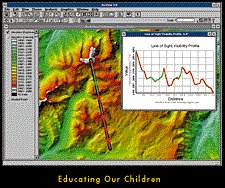

 |
 |
Geography Matters for Schools and Libraries Geography is part of the places we call our home, our neighborhood, our nation, our planet. It is meaningful because it defines where we live, who we are, and what we hope to be. Geography ties together all aspects of the earth and its many societies. Geography is part of the places we call our home, our neighborhood, our nation, our planet. It is meaningful because it defines where we live, who we are, and what we hope to be. Geography ties together all aspects of the earth and its many societies.Often overlooked because we simply don't see it, geography and its questions of where and why find broad exposure in schools, libraries, and similar educational institutions. In a school or library, geography finds a place in more than just a geography classroom or map reading room. It is part of many disciplines such as geology, biology, environmental science, mathematics, sociology, economics, and literature. GIS for Geographic Education A GIS (composed of mapping software, geographic data, and a questioning explorer) allows students and persons of all ages to ask and answer geographic questions by designing and analyzing maps using user-selected criteria. Because a GIS is not a sit-back-and-watch gadget, persons creating GIS maps are building their thinking skills, expanding their knowledge of the world, seeing connections between and among things, and gaining new informational and technological skills. A GIS in a local school or library also can offer a new connection between these institutions and the community. Students and local residents accessing information about their hometowns will find they are better informed on community successes and problems. In the process, they may find themselves more actively involved in their communities. This same geographic tool also can open a doorway to a range of vocations. Just as geography is tied to everyday life, GIS is tied to a diverse and growing array of occupations. Archaeologist, farmer, realtor, park ranger, geologist, police dispatcher, and historian are but a few. If you would like to know more, we invite you to explore our many informational and downloadable resources. |